Principle of operation
First of all, we suggest you figure out how an induction cooker still works? It is not difficult to guess about the principle of operation of a gas or conventional electric stove. In a gas stove, a burner with a flame serves as a heating element, in the second - a heating element, which heats up to the desired temperature.
Device an induction cooker is completely different: heating occurs due to the induction current and it heats not the burner itself, but directly the dishes that are on it.
Consider principle of operation induction hob step by step:
- electric current is supplied to the device through the socket and cable;
- the charge enters the voltage frequency converter;
- the converted charge is transferred to a magnetic coil that creates a magnetic field;
- Eddy currents are transmitted to the bottom of the cookware, creating the movement of electrons and, accordingly, heating the food.
Electromagnetic radiation, on the basis of which modern induction panels are created, was discovered back in the 19th century (1831) by physicists Joseph Henry and Michael Faraday. The technology has been used for household needs since the 1870s, so it cannot be called completely new. The boom in recent years is more likely the result of mass production of induction cookers, and not the novelty of thought.
Types and characteristics
Do not confuse induction cookers with other electric ones. In addition to induction burners, hobs can have open cast iron heating elements or halogen heating elements hidden under glass ceramics. There are also combined models in which there are both conventional burners and induction under the glass-ceramic surface.
All induction cookers are electric, but not all electric ones are induction.
Characteristics induction:
- Power consumption... Everything is learned in comparison, therefore, it is easier to calculate the cost of electricity, correlating with other types of stoves. Fortunately, the results of the experiments can be found in the public domain. To heat 2 liters of water, a cast-iron stove spends almost 10 minutes and 320 W, a halogen one - 9 minutes and 270 W, and an induction cooker - a little less than 5 minutes and 225 W. Wherein Induction efficiency more than 90%, which is almost 2 times higher than any other model.
- Power... Although the declared energy consumption is usually higher than that of halogen species, in fact induction cookers consume it more economically, because do not heat the coating itself and the air.
- Temperature... One of the advantages of induction is the most precise control possible. On many models, you can set not just a number from 0 to 9, but a specific number - for example, 200 degrees. Some cookers have preset automatic modes - frying, stewing, boiling, etc. Another plus - some models have constant, not wave heating, which allows you to maintain the desired temperature for a long time.
Varieties of slabs by installation method
- Tabletop... Compact models are usually produced with 1-2 places for dishes.Their main advantage is in design and small size: the tabletop tile is easy to take with you on vacation or to the country, it does not take up space on the countertop and can be stored in the closet between uses.
- Freestanding... Manufacturers make them complete with an oven. They do not need a separate building, because have a stable base.
- Embedded... The most popular option today is hobs that cut into the worktop. They look minimalistic, stylish, and can be installed anywhere on the work surface.
By the number of burners
- 1... Portable household appliances usually have a rack for only one pot or pan.
- 2... The 2-burner induction hob can be built-in or portable.
- 3... The external dimensions of a triple induction hob do not differ from a 4-hob, but the stands have a larger diameter and allow you to place larger kitchen utensils nearby.
- 4... The standard option that everyone is used to: often has additions in the form of a hotplate with maximum power or several circuits.
There are also induction hobs "without burners". Their working surface is located under the entire area, the device independently determines the installed dishes and understands exactly where it needs to be heated.
Pros and cons
To better understand the features of induction cookers, we will list the pros and cons.
Benefits induction cookers:
- Profitability... As we have already found out, due to the high efficiency, induction machines consume less electricity - which means that you will have to pay less for light.
- Speed... Induction dishes cook quickly, at least due to an instant set of temperature - no need to wait until the ten is heated. It takes only a few seconds from the moment of switching on to the release of maximum heat energy.
- Ease of use... Cooking on such a stove is a pleasure. In addition to the specified functions such as boiling and frying, the "intelligence" of the stove should be noted - it heats up only when there is a suitable dish on it. It is not possible to enable induction by mistake. Another "gadget" - a timer - is found in almost all modern models. Set the desired time and the stove will turn off by itself.
- Safety... When there is a small child in the house, leaving him alone in the kitchen is a high risk. Children love to twist the levers and press the touch buttons. But in the case of an induction cooker, you should not worry - do not store dishes on it and it will definitely not turn on, which means that the baby will not be able to get burned.
- Ease of cleaning... The surface of the induction hobs is smooth glass. It is enough to wipe this with a cloth after cooking. And if you forgot, it doesn't matter, even if the stove is dirty enough, it can be quickly cleaned using special tools.
- Intuitive controls... For cooking, you do not need to have special knowledge: usually on the stoves there is an on / off button and adjustment of each burner, which can be dealt with in a few seconds.
Unfortunately, not everything is so cloudless. Induction has and limitations:
- High price... The prices for devices operating in a ferromagnetic field differ by about 20-30%.
- Additional costs for dishes... For the stove to work, you need to put on it a suitable saucepan or skillet: by no means all cookware is capable of being “magnetized” to the burner. Probably, after buying a stove, you will have to say goodbye to your favorite utensils. Which is not only insulting, but also expensive - after all, induction cookware is more expensive than usual. But this problem is solved if you buy a special adapter.
- Noise when switched on... Due to the principle of operation, induction units are quite noisy - but not louder than working hoods.
- Harm from exposure to currents... An ordinary person who does not part with a mobile phone will not be harmed by an induction cooker. But people with heart stimulants are better off not using them.
So, with the score 6: 4 in favor of the induction system, let's move on!
How to use?
They do not write special rules for induction devices: their control is simple, but the instructions for your specific model will help to understand it in more detail.
However, there is general information that everyone should know. For example, differences in requirements for dishes:
- Not all metal utensils are suitable for cooking. For example, the stove will not work with budget aluminum saucepans and cauldrons.
- Suitable utensils include cast iron, steel, enamelled, copper.
- To make sure that the dishes will fit exactly, you can carefully examine the packaging: look for the spiral icon or the Induction inscription.
- An equally important parameter is a flat bottom! For a number of reasons, there should be no protrusions or notches on it - as flat as possible is best.
- The bottom of small containers should not be less than 12-14 cm. Turks are too small, the ladles of the stove simply do not heat up.
- The distance between the edges of the burners and the bottom of the cookware should be approximately the same. In this case, it is better to take the dishes with a smaller mug than a larger one, and put them in the center.
Advice! A convenient way to check dishes is with a fridge magnet. If it sticks to the bottom, then the pan fits.
Useful advice:
- In various sources, you can find information that the burners of the stove do not heat up - on the one hand, this is true, heating occurs immediately on the dishes. On the other hand, heat from the bottom is transferred to the surface, therefore do not touch the stove after switching off.
- Most induction devices are equipped with a protection system: they automatically turn off after 180 minutes of continuous operation, and the power is blocked when various liquids enter. Please consider this before purchasing.
- Additional functions such as Booster (transferring energy to an adjacent hotplate) or keeping warm make life much easier.
Care features
To maintain the original appearance of your induction hob for years to come, get in the habit of washing it after every use. For regular wiping, a sponge with dish soap and a dry towel are enough. Use paper towels to remove streaks.
Important! The panel can be washed only after it has completely cooled down!
If the stove is dirty, purchase a special glass ceramic cleaner: they usually contain acids or alkalis, so before use it is better to protect your hands with gloves and your lungs with a respirator.
Important! Do not use abrasive products or metal brushes to avoid scratching the surface.
And finally, remember: the induction of induction is different! Be sure to read reviews and buy equipment only from trusted manufacturers.

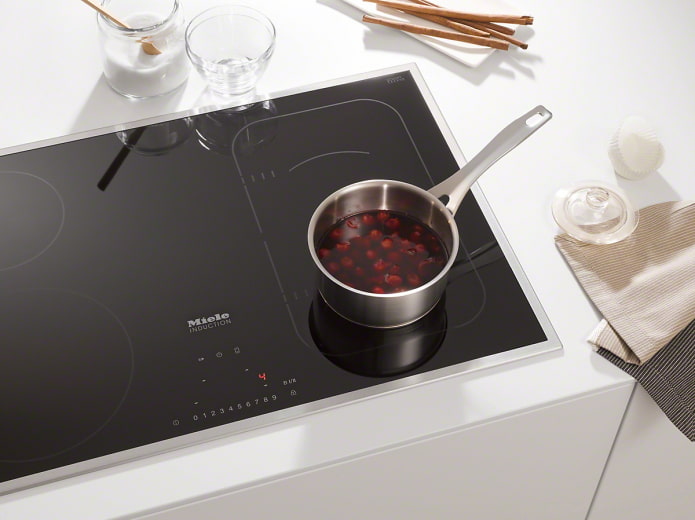
 10 practical tips for arranging a small kitchen in the country
10 practical tips for arranging a small kitchen in the country
 12 simple ideas for a small garden that will make it visually spacious
12 simple ideas for a small garden that will make it visually spacious

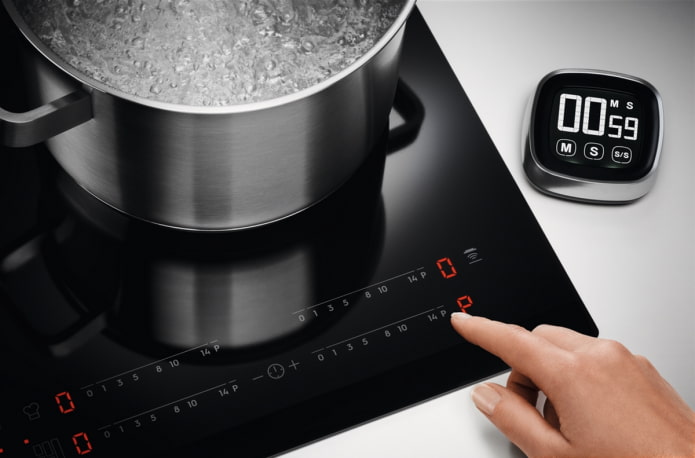
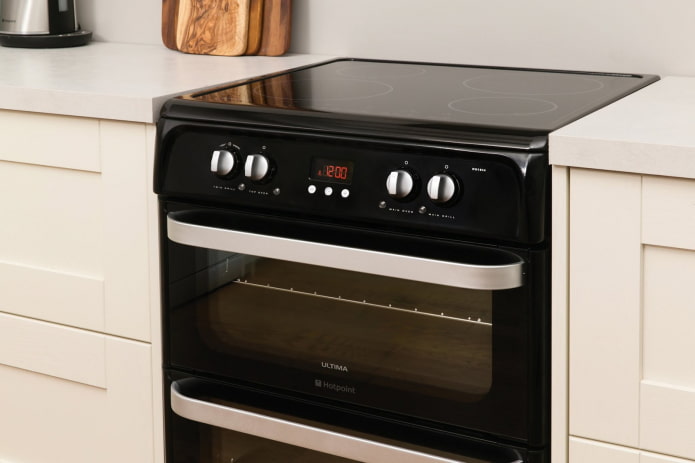
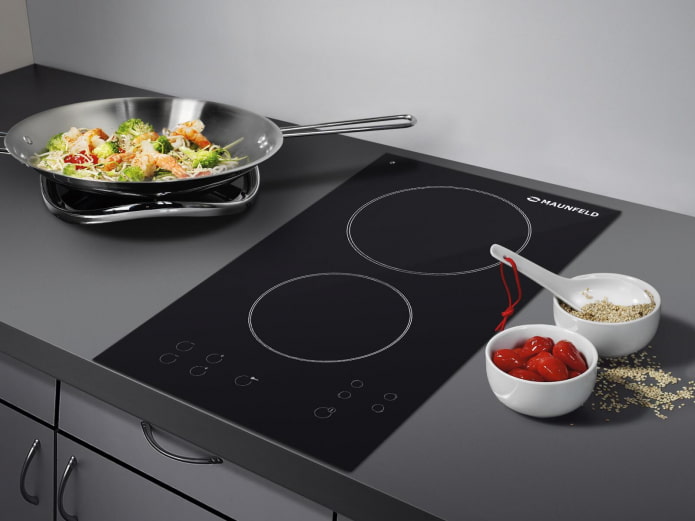
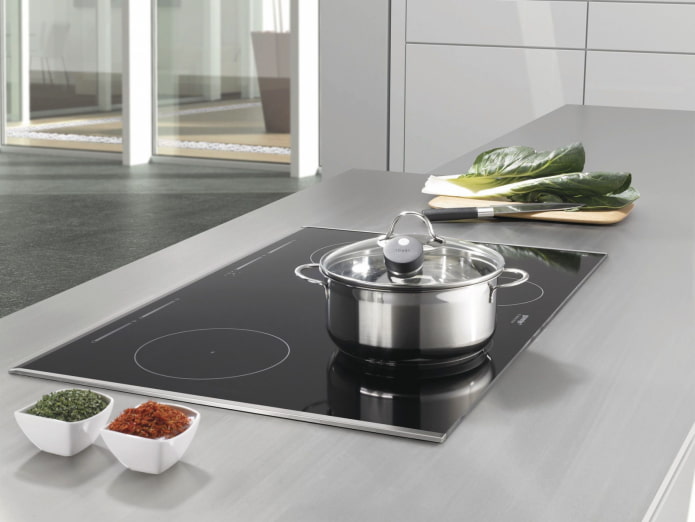

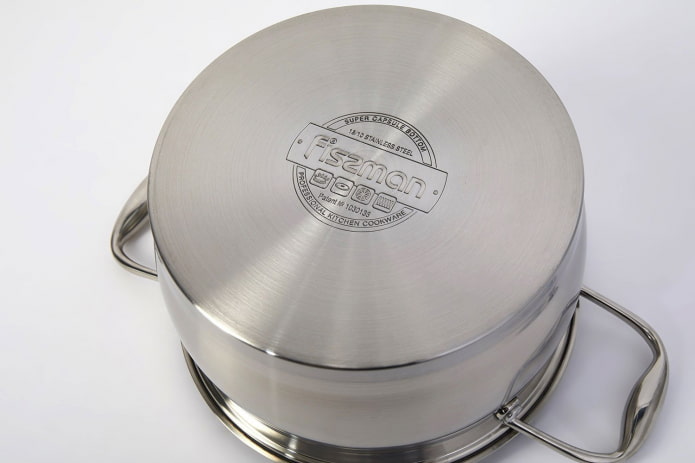



 How to choose the color of your kitchen sink?
How to choose the color of your kitchen sink? White kitchen set: features of choice, combination, 70 photos in the interior
White kitchen set: features of choice, combination, 70 photos in the interior Black set in the interior in the kitchen: design, choice of wallpaper, 90 photos
Black set in the interior in the kitchen: design, choice of wallpaper, 90 photos How to choose curtains for the kitchen and not regret it? - we understand all the nuances
How to choose curtains for the kitchen and not regret it? - we understand all the nuances Design of a white kitchen with a black countertop: 80 best ideas, photos in the interior
Design of a white kitchen with a black countertop: 80 best ideas, photos in the interior Kitchen design with green wallpaper: 55 modern photos in the interior
Kitchen design with green wallpaper: 55 modern photos in the interior